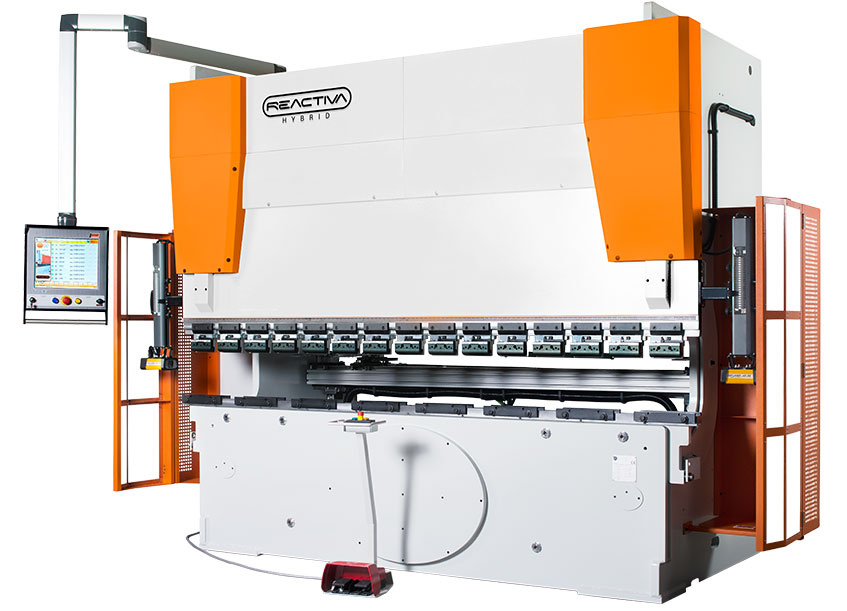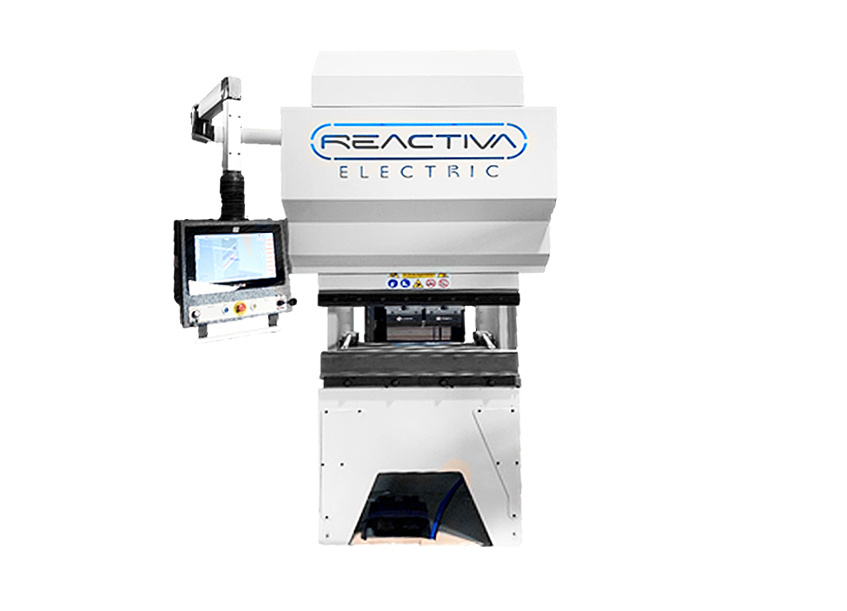Types of bending machines
Mechanical press brakes
Mechanical press brakes have an extremely fast movement and a large pressing force. Their characteristic is that once activated for a bending cycle they cannot be stopped, this forced the operators to pay great attention during the installation of the tools and in the correct identification of the limit switch.
Mechanical bending machines are today considered outlawed due to their lack of safety and cannot be used.
Hydraulic folding machines type “RG”
They are simple, reliable, compact press brakes and have made the history of sheet metal bending. They have an inverse movement compared to other bending machines: normally it is the upper part (crossbar) that goes down, instead for these presses it is the bench that goes up. The movement is generated by a single central cylinder. Today they no longer comply with safety regulations as they do not have the speed change point and, in many cases, the protection photocells, but if updated with specific safety upgrades, they can be used.
Hydraulic torsion bar press brakes
They are the forerunners of the synchronized folders to which they resemble in appearance. The movement works through the crossbar that goes down thanks to a pair of hydraulic pistons. The axes of movement are limited, three at most and are: X for the rear stay, Z for the height of the rear stay, Y for the descent of the crossbar. The two pistons are often mechanically connected to each other through a bar that couples the movement up to the bottom dead center. The latter is regulated through the movement of two nuts that descend or rise to adjust the height of the cylinder limit switches and, therefore, of the crosspiece. Machine control is entrusted to a simple two or three axis positioner. Often this device has no internal memory and is therefore to be programmed whenever a piece with more bends is to be made.
Synchronized hydraulic bending machines
It is the most widely used type of modern press brake today, it is characterized by the movement of the upper crosspiece by means of two independent hydraulic cylinders regulated by proportional valves.
Electric press brakes
They represent the evolution of bending machines, thanks to speed, low consumption and precision.
The movement of the crosshead is generated electrically through various systems such as recirculating screws instead of hydraulic cylinders or belts.
Hybrid press brake
These Hybrid Press Brakes are the best compromise between precision and power, thanks to the mixed electro-hydraulic system
They represent the latest evolved generation of folding machines, together with electric folding machines.
How is a press brake made?
The crossbar (or ram)
It is the moving part on which the punches are installed. It slides along a vertical movement corresponding to the Y axis and is positioned in specific points depending on the processing to be performed, at dimensions translated by the numerical control. To be precise, there are independent Y1 and Y2 axes that regulate any unbalance of the machine. In a hydraulic press they correspond to the different strokes that the cylinders can perform; for an electric belt, for example, in any case the different descent levels between one end of the crossbar and the other.
The counter
It is the fixed part below the crosspiece and where the matrices are installed. It can contain, especially in the presence of machines from two meters in width, a bending system (or camber) aimed at compensating for the deformation of the crosspiece. This system varies greatly according to the type of machine, both for different design philosophies among manufacturers and for the type of machine. For example, the deformation of the cross member of a hydraulic machine constrained at the ends by the hydraulic cylinders is completely different from that of an electric belt, which provides the thrust in a much more distributed way throughout its width.
The shoulders
They represent the side plates that delimit the width of the frame of the machine frame. They too can be of different types. For example, in synchronized hydraulics, they almost always have a recess that allows the insertion of the sheet beyond the width of the shoulders. In the case of an electric belt, however, they appear as a "closed" structure and placed at the ends of the machine in a very different way.
The numerical control (CNC)
The brain of the bending machine, the device with which the operator interfaces through direct or off-line programming from the technical office.
The numerical control CNC allows multiple programming modes such as numerical mode or graphic mode. The numerical mode allows the operator to enter the data relating to the piece to be made directly in the appropriate boxes. The simpler graphic mode involves the use of a two-dimensional or three-dimensional graphic interface that depicts the shape of the finished piece and also the bending sequence.
Back register
It is the device that allows to carry out the correct bending length. Generally it is composed of a beam on which two or more "strikers" (backgauges) are mounted, free to translate laterally to arrange themselves in the correct position.
The axes of a bending machine
The axes (in the nomenclature) are rather uniform among machine builders and are:
• x: “back and forth”, adjusts the length of the bend (flange)
• r: "up and down", adjusts the height of the carriage for better support of the piece and the possible mounting of dies of different height
• z: "right and left", adjusts the position of the striker on the carriage, to ensure the right support position for the execution of the piece
Bending tools
In three-point bending, that typical of bending presses, two groups of tools are used:
• upper, commonly called punches or knives, are placed at the top, integral with the crosspiece
• lower, called matrices, slots or prisms, installed directly on the machine workbench
How to bend the sheet? a perfect fold
The sheet metal bending technique
Bending is a process aimed at deforming the sheet by bending.
The bending of the sheet metal is possible thanks to the characteristic of the various metals of having a "neutral fiber" inside them in the center of the sheet thickness which, without stretching or contracting, can be deformed. The choice of metal is very important in the bending of the sheet metal because it must be plastic to the point of not generating breaks near the bend.
An important event is springback and its correction. The bending phase generates on the sheet the stretching of the external fibers and an upset of the internal fibers, generating a translation of the neutral fiber inwards; from this derive internal tensions which are released after bending producing the elastic return.
The folding techniques
Bending in the air
The bending in air takes place by means of an upper punch which, as it descends, presses the sheet into the lower V-shaped die. During the pressure the sheet has three points of contact with the machine: one on the upper punch and two on the die, to determine the angle of bend is the depth at which the punch presses the sheet into the die.
In this process the elastic return is compensated by a greater penetration of the punch; this involves the phenomenon of over-bending, that is, making a greater bend that compensates for the elastic return allowing you to obtain the desired angle.
The lower force required compared to other types of processing that allows even thick sheets to be bent is the advantage of air bending as well as the possibility of obtaining different angles using the same tools.
The main disadvantage of this process is the difficulty in balancing the penetration of the strut to compensate for the elastic return; hence the need for a highly technological press brake to guarantee maximum precision.
Coining or Hollow bottom fold
Coining involves the use of a punch that presses the sheet completely down to the hollow bottom of the lower die. In this process the punch and the die must have the same angle of inclination.
Coining, or hollow bottom bending, is mainly used for bending 90 ° corners with thin sheet metal. The main advantages include precision, the possibility of obtaining lower angles with respect to the bending in the air and the constant repeatability of the bending angle; this makes this technique almost more similar to molding.
The main disadvantages of coining are the need to use different tools for each desired angle and the need to use a high bending force.
Crushed or Flattened
The flattening takes place in two phases: a pre-fold at 26 ° -35 ° (obtained by folding in the air) and a subsequent crushing in which the sheet is completely or partially crushed.
This technique is normally used to obtain rigidity, edge protection and to avoid free edges; usually specific presses are used for flattening.
Fields of application
The fields of application of bending are many as bending sheet metal, even more so with the use of a press brake, is one of the best and cheapest ways to perform prototypes and batches even in very small series.
Not having to resort to expensive molds or long mechanical processes makes bending an extremely fascinating, rich and requested process. Normally sheet metal bending finds its use in the field of light carpentry such as: casings, metal furniture, household appliances, indoor and outdoor furniture, production of all types of machines, aeronautics and aerospace.
Or, in the field of heavy carpentry with the production of structural elements in construction, poles for the energy sector, telecommunications and much more, such as components for the naval, railway and road transport sectors.
Sheet metal bending: what to keep in mind
There are many aspects to consider when planning a bending process and can be briefly summarized in:
• Which machine do we have available: it means foreseeing the possibilities and limits of our press brake through the knowledge of the stroke, the span, the maximum force, the dimensions, the size of the recess.
• Which tools, through knowledge of the shapes available in the company or by the supplier, their capacity and lengths.
• Check in advance the list of "what you need" and "what you have" to have an immediate clear picture that protects you from possible errors and waste. In other words: learn how to perform a systematic feasibility study.
• Adopt procedures that go towards quality such as, for example, linking the developments of the pieces to be bent to specific equipment to be reported on the drawings to guide the benders to install them correctly, obtaining compliant items.
• Adopt the necessary safety measures for machines and tools: even if there are residual risks, modern press brakes offer advanced protections that do not limit processing as in the past. Even if the machines are used, in most cases, they can be adapted with specific kits that make them current from a regulatory point of view.
How to set up a press brake
Select and size the machine that's right for you
A press brake is a simple machine in the principle of operation, but very flexible and rich in accessories. The infinite variety of thicknesses, lengths and shapes require a great customization of dimensions, powers and tools. This is why it is important to analyze in detail the production needs in order to purchase a machine that is able to perform its task perfectly.
The fundamental points to take into consideration when choosing, sizing and configuring a press brake:
Length
Tonnage
Light and travel
Recess
Clamps and intermediates
Back register
Compensation systems
Energy saving systems
Front supports and companions
Angle control systems
Options and accessories
WIDTH
It depends on the maximum length of the workpiece. If you fold by stations, or with more equipped stations, you will have to add up the length of the individual stations. For example, let's take a 700 × 1800 mm panel. You can fold all the short sides first, retool the machine, and then fold all the long sides. In this way, a 2000 mm long bending machine would be enough, but the work would be less efficient. The other solution is a 3000 mm machine with two equipped stations, one for the long side and one for the short side
TONNEL
It is the folding capacity of the machine. These are the determining factors:
- Material: more ductile metals such as aluminum require a lower tonnage than stainless steel or high strength steel
- Thickness
- Length
- Processing: bending in the air requires less force than coining or pressing.
- Sizing the bending force of a press brake is certainly one of the most important steps when choosing this type of machine
It is always advisable to oversize the press brake by 20% / 30% compared to the theoretical data, in order to manage the variability in the characteristics of the material and not to work at the limit of the machine's capabilities.
Work area: LIGHT, STROKE AND RECESS
The light is the front opening of the press brake. A press brake equipped with intermeets allows to easily make boxed boxes without using special punches. The version with increased stroke allows you to extract bent pieces more easily.
The hollow is the C-shaped opening made in the side shoulders. It varies according to the total size of the press brake. The version with increased recess is useful for sideways extraction of the pieces or for tandem machines.
LOCKS AND INTERMEDIATES
The various locking systems allow you to change and move tools. The more fragmented the production, the more the importance of saving time in retooling is felt.
The intermediates are adapters to be inserted between the crossbar and the punches. They allow you to easily create deep boxes without having to use long tools, usually very expensive and more delicate. Long tools can however be mounted directly on the crosshead.
Manual locking , simpler and more robust, but also the most complex when changing tools. Suitable for processing large batches with little variability in tooling.
Pneumatic locking , easy, fast, allows the front tool change from bottom to top. It is self-aligning and guarantees excellent flexibility.
Hydraulic locking , according to the capacity only to the manual one, allows you to change tools at a reasonable speed, combining flexibility and tonnage. It is not available with European type tools.
Energy saving, supports and angle control
Consumption reduction systems, the various types of front and accompanying supports, and angle control systems.
ENERGY EFFICIENCY
Shuts down the engine after a period of inactivity.
Thanks to the hybrid system, it is possible to vary the motor speed continuously, adapting it to the bending cycle. The advantages are reduced consumption, less stress on the oil and the pump, less noise, more speed and more flexibility.
Are you looking for a press brake that allows you to save energy while maintaining the same results? Choose a REACTIVA energy saving folder: less consumption, more speed.
Robot integration: Automate production for large volume bends with high precision and efficiency







